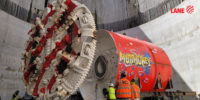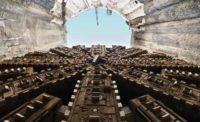
Alan Barnhart knew that it would have been, in his own words, "absolutely catastrophic" if his crews damaged even one part of the world's largest working tunnel-boring machine, a 7,000-ton, 57.5-ft-dia drill nicknamed Bertha, which was designed to bore out the new Alaskan Way Viaduct in Seattle.
 |
| BARNHART |
The firm, Memphis-based Barnhart Crane & Rigging, was charged with transporting the TBM's 41 individual pieces—the largest weighing 850 tons—from a freighter docked at the Port of Seattle, 500 yards across port property and then 80 ft into the launch pit, where Bertha was assembled.
Barnhart Crane did it all last May without incident, and precision was the key. "It took a lot of work in pre-planning," says Barnhart, the firm's president and owner. "It was a major effort, and our engineering department put in thousands of hours."
Key team leaders—including Barnhart; his brother Erik Barnhart, the firm's chief engineer who helped design the concept; Matt Brennan, vice president of operations; James Taylor, vice president of construction; and Scott Fletcher, an engineering manager who has since left the firm—all proved critical in devising 41 exacting lift plans while creating an innovative lift-tower solution for the tight urban footprint.
"The unloading and transporting was a monumental achievement," says Chris Dixon, project manager for the project's design-builder, Seattle Tunnel Partners. "Most importantly, it was performed efficiently and safely without any injuries, damages or incidents." By all accounts, Bertha's bore got off to a solid start, though she later became stuck due to an obstruction that engineers are now investigating.
Barnhart, who jokes that he has a "boring résumé," has worked at the business his parents started, in 1969, since he was 10. He's now 53. He credits the success in Seattle to building, from the 1,000-employee firm, a team capable of handling the schedule and challenges.
It all added up to, as Barnhart humbly says, a "pretty unique, elaborate project."




Post a comment to this article
Report Abusive Comment